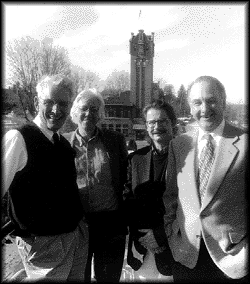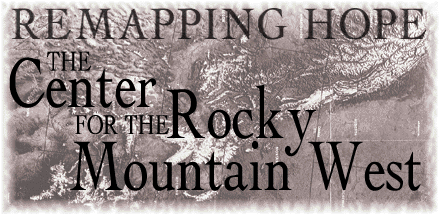WINTER 1998 Montanan - Volume 15, Number 2
by Kathy Witkowsky
"The Rocky Mountain West is not so much a place as it is a hope in America," says former Congressman Pat Williams, now a senior fellow at The University of Montana's Center for the Rocky Mountain West. "Our center is trying to explain the meaning of that."
The idea of taking a broad look at the region and the issues it faces has been tossed around for years by some of the University's most distinguished faculty-H.G. Merriam, K. Ross Toole, Paul Phillips and Richard Hugo. In 1992, with a $600,000 gift to the University, the idea came to fruition. The center's endowment is currently nearly $3 million, thanks to a National Endowment for the Humanities Challenge Grant and support from donors, most notably Carroll and Nancy Fields O'Connor. A $300,000 grant from the William and Flora Hewlett Foundation will also help support the center's operations over the next three years.
Located in the eighty-eight-year-old Milwaukee Station in downtown Missoula, the center acts as a bridge between the academic world and the community at large through conferences, lectures, classes and a Web site. It operates on two basic premises: that communities up and down the Rockies face similar issues with values more similar than they might suppose. And that the region-and its people-is experiencing major social and economic transitions caused by globalism and a massive population shift.
Thinking Like a Region

Center principals (left to right) William Farr, Daniel Kemmis, Larry Swanson and Pat Williams in front of Missoula's Milwaukee Station. Most Missoulians believe they live in the northern Rockies. Actually, they live in the middle of the Rockies, points out UM history Professor William Farr. As associate director for humanities and culture and founding director of the center, Farr tries to flag these misconceptions and encourage a "return to an understanding of the region in which you're following natural landscapes."
Daniel Kemmis, center director and former Missoula mayor, sees the center as a resource for helping the region "think and act like a region." In the future, Kemmis says "regionalism is going to become more and more important" as globalism erases many of the jurisdictional lines of nations, states and counties. He predicts that bioregions will emerge as political entities. Kemmis, who recently won the Wallace Stegner Award for his contributions to the American West, extensively explored this brand of "place-based politics" in his two books, Community and the Politics of Place and The Good City and the Good Life. In his book-in-progress, he further develops his theory about bioregional political bodies. "Almost without exception the boundaries of western states are arbitrarily drawn," Kemmis says, "so you're trying to govern a place that increasingly is ungovernable."
According to Kemmis, Missoulians have at least as much in common with inhabitants of Boise, Idaho, or Moab, Utah, as they do with the residents of Montana's own Miles City. The center wants to help the citizens of the Rockies-from northern New Mexico and Arizona to Alberta-recognize these commonalities.
One way to do that, he says, is to develop a western charter-a statement of principles to guide people as they grapple with western issues. Kemmis is working on a charter that would incorporate feedback from governors, legislators, industry representatives, environmentalists and public interest groups from the Rocky Mountain region and the West Coast.
Not All Talk in a Room
Sound highbrow? Perhaps, but "this is not all talk in a room that goes nowhere." Williams says. "It's to better prepare people in the cities and towns in the Rockies for the coming challenges of increased population, new economic and environmental concerns." And please, says Farr, don't use the "T" word. "We don't want to be thought of as a think tank," he says. "Anything but."
The center is actively working to sharpen westerners' understanding of the issues affecting communites up and down the spine of the Rockies and on both sides of the border. Center members are in the process of proposing ways to better coordinate local and federal environmental decision-making in a report for the White House Council on Environmental Quality. And Williams, who also teaches at UM, hopes to set up quarterly discussions between policy makers about environmental issues facing the Rockies. He'd also like to initiate annual discussions between Canadians and Americans regarding Glacier and Waterton national parks-which share borders as well as environmental concerns.
Rethinking the Region
The Canadian and American Rockies share more than just a border, says Larry Swanson, the center's associate director for regional economics: They share trade, which continues to grow following passage of the North American Free Trade Agreement (NAFTA) and the General Agreement on Tariffs and Trade (GATT). "For hundreds of years, we've had nation-states with economies confined within them," Swanson notes. "These new trade agreements render nation-states nearly obsolete in terms of trade. We need to change our thinking to keep up with this new transnational economy."
Consider this: in Kalispell, the largest influx of out-of-state dollars doesn't come from Washington, Oregon or Idaho-it comes from Canada. That's not news to American Indians, who traded along the corridor long before European settlers mapped the United States or Canada. But businesses and communities consider themselves part of their states, not their regions. In the next decade, regionalism will grow in importance as the Rockies-both American and Canadian-expect to record the nations' largest population growth. "It's a real challenge," says Swanson. "But it's also an opportunity to rethink this region economically, socially, politically and environmentally."
The West is at the front end of an economic transition, according to Swanson, "from an extractive-based economy to one in which extraction is an increasingly minor component." That trend is expected to continue. "If you're going to have extractive industries, you've got to do it in ways that don't jeopardize your environmental future," he warns. "A high-quality environment has become an essential part of our economy." The center holds regular regional economic forums to help communities cope with this transition.
Back to the Future
Transition will prove much easier if the citizens of the Rockies better understand their history and culture. That is why the center focuses attention, through lectures and discussion, on the contributions of Native Americans in the region. "Americans know almost nothing about the Native American society in its past and very little about it today," Williams says. "So much of what we do today in the Rockies was handed down from the first people-some of our language, the way we dress, what we eat."
The center also sponsors conferences and lecture series that examine old and new ideas of the West. At the center's 1997 conference, "A.B. Guthrie's The Big Sky After Fifty Years," Guthrie's Pulitzer-Prize winning novel was a springboard for authors, historians and filmmakers to offer their end-of-the-century perspectives on the history, culture and society of the West-and its future as well. Next year's conference in Great Falls will focus on Joseph Kinsey Howard, author of High, Wide and Handsome. From this stew of ideas, the center hopes to eventually publish an anthology of literary and historical essays about the region.
That's just for now. But the center is always evolving. "We're trying to connect with best of the past," Farr says. "And at the same time we're involved in a genesis of the regional culture that relies on the past but is different than what we've had.
"Right now," he adds, "our biggest challenge is to get out of Dodge, to have a presence beyond Missoula."
Kathy Witkowsky is a free-lance writer in Missoula.
M
